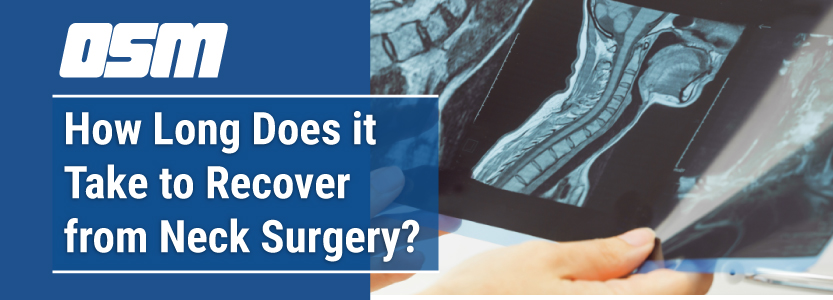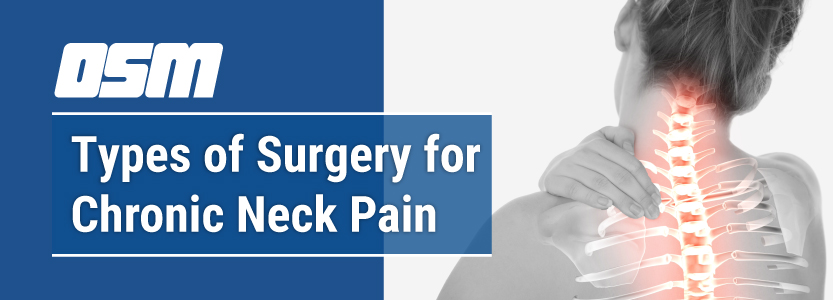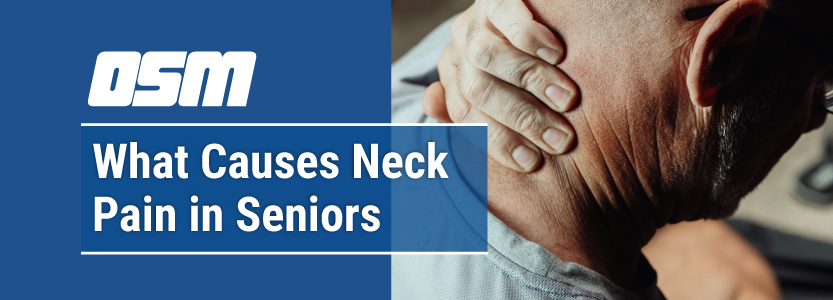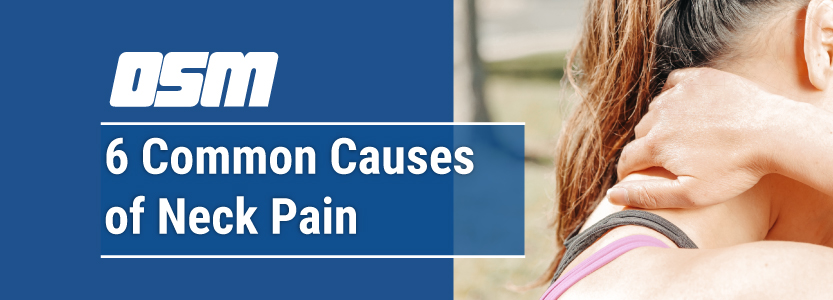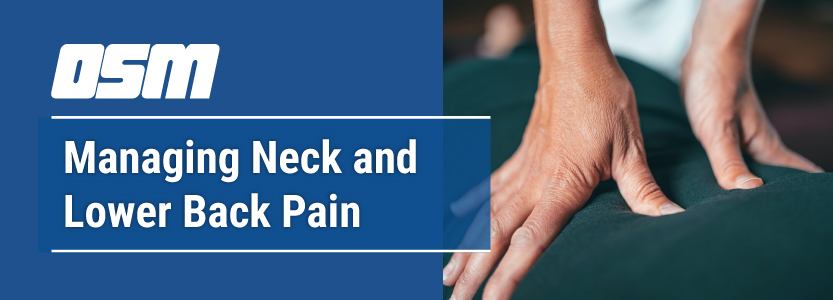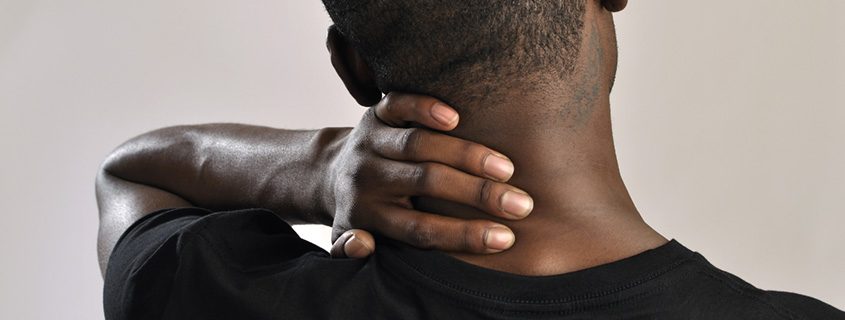Article featured on Practical Pain Management
The human neck houses incredibly important structures—the airway, the voice box, the food-entry canal (esophagus), all the nerves in the spinal cord, and of course the muscles and bones that “keep our heads on straight.” As a result of this plethora of activity, neck pain can arise from a variety of sources.
Neck pain can imply something simple like a stiff muscle, which can often be worked out with rest, therapeutic manipulation, or exercise. But neck pain can also be a warning sign of a medical emergency, such as in the case of bacterial meningitis (which can threaten one’s life) or cervical myelopathy (which can lead to paralysis). In these situations, seeing a doctor to distinguish the significance of your particular form of neck pain is warranted. Below is an overview of six potential sources of neck pain. See also our diagnosis and treatment sections for each.
1. Muscle Strain:
A strained muscle or group of muscles is often the source of neck pain. Strains can be caused by weight (including obesity), weak abdominal muscles (your “core”), or poor posture.
New studies about “tech neck” or “tablet neck” show that those who put themselves into odd positions while holding handheld electronic devices can also cause neck strain; try to avoid placing the device in your lap, which causes you to flex your neck down to look at the screen. The weight of the head on the spine, normally about 10 to 12 pounds, can increase to 60 pounds of load on the spine when the neck is flexed 60 degrees (See Hansraj, 2014).
Muscle-based neck pain can also occur from over-extending the neck. Sometimes called “belayer’s neck,” this position can be best described as a person standing at the bottom of a cliff and assuming a constant gaze upward to shift ropes and watch out for the safety of a climber. Not only are muscles affected by this position, but the facet joints of the spine are jammed together.
Certain occupational activities, sports, hobbies, and even sleeping in an odd position can lead to musculoskeletal neck strain and pain as well. A fall or car accident can spur muscular neck pain in the form of whiplash, leading to potential long-term damage or disability.
2. Cervical Disc Herniation:
In between the vertebrate in your spine are discs that serve as a cushion to the vertebrate above and below. Sometimes, through trauma or normal age degeneration, the outer hard layer of a disc breaks, and the inner, gel-like nucleus pulposus squeezes out, irritating the nerves behind it. This action is referred to as a herniated, bulging, slipped, or ruptured disc. When discs rupture within the cervical spine—that is, the vertebral column in the neck area, the movement can produce pain. Symptoms can also include pain between the shoulder blades or pain/numbness that radiates down the arm to the hand or fingers.
3. Rheumatoid Arthritis:
For individuals with rheumatoid arthritis (RA), neck pain typically comes years after the diagnosis; over 80% of patients who have had RA for 10 years wind up experiencing cervical spine issues (See Hamilton, 2000) as the disease can lead to damage in the hands, wrists, elbows, knees, and ankles. At higher risk are male patients and those with a positive rheumatoid factor, which your rheumatologist can likely share with you.
The good news is that neck pain is rarely the first known symptom of rheumatoid arthritis. When it does present in the neck, RA usually affects the atlantoaxial joint. This particular joint pivots the head so we can look left and right, up and down. As RA loosens ligaments, erodes bone, or causes thickened tissue around joints, the spinal cord and brain stem can condense, requiring urgent medical attention. Therefore, although rare, RA retains its spot on the list of possible neck pain causes even when there is no evidence of RA in the peripheral joints (eg, hips, knees).
4. Meningitis:
One of the most dangerous sources of neck pain is bacterial meningitis (also called meningococcal meningitis), as a person can go from neck stiffness to death in a matter of hours to days. The three membranes that coat and protect the brain and spinal cord, running through the neck and back, are called meninges. The dura mater guards the outside, the arachnoid mater serves as the webbed middle layer, and the pia mater shelters the central nervous system as the inner layer of meninges.
While the meninges shield our central nervous system (CNS), there are certain bacteria, viruses, and even fungi that can inflame and destroy these layers. Two of the most dangerous bacteria that can threaten one’s life rather quickly are called Neisseria meningitidis and Streptococcus pneumoniae. The bacteria are passed through saliva and the most common symptoms include fever, headache, and stiff neck. If you experience such symptoms, it is important to seek immediate medical attention.
While the highest global incidence of meningitis outbreaks occur in Sub-Saharan Africa, Centers for Disease Control and Prevention (CDC) data show that outbreaks can also occur in communities, schools, colleges, prisons, and other populations around the US. Viral and fungal forms of meningitis also exist, but are often less severe.
5. Tumors:
Since the airway is contained in the human neck, a lifetime of inhaling a toxic substance, such as asbestos, wood, nickel, dust, or tobacco, could mean that neck pain is being caused by a tumor. At least 75% of head and neck cancers are caused by tobacco and alcohol use (See Blot, 1988). Cancers in the neck usually involve abnormal cell growth in the squamous cells, which are the moist, mucosal cells that line the mouth, nose, and throat. Less often, neck cancer originates in the salivary glands or thyroid glands.
Sometimes cancer originates in squamous cells elsewhere in the body and then spreads to a neck lymph node, creating a lump. This cancer is called metastatic squamous neck cancer with occult primary. Symptoms can include pain or a lump in the neck or throat.
Human papilloma virus (HPV) is a growing culprit in oropharyngeal cancers; according to the National Cancer Institute, HPV is the source of 26,000 new head and neck cancers each year.
6. Cervical Myelopathy:
This version of neck pain usually indicates that immediate surgery may be needed. If you notice pain or numbness in your arms or legs, frequent tripping, or sudden bladder incontinence, it may be because the spinal cord is being compressed. Known as cervical myelopathy, the condition can lead to permanent disability or paralysis if left untreated, which is why surgery is usually advised.
Degenerative cervical myelopathy, also called osteoarthritic or cervical spondylosis, occurs when any of a host of degenerative problems occur, such as herniated discs, swollen ligaments, or bone spurs. Bone spurs, also called osteophytes, can grow as a result of osteoarthritis, poor posture, or traumatic injury; changes that are more common with age. Continued degeneration or trauma can lead to cervical stenosis, which means that the space in the spinal canal has narrowed. When this narrow canal pinches the spinal cord, myelopathy, or neurologic deficits (abnormalities in body function), can occur.
Overall, diagnosing neck pain can be tricky, but with the proper medical exams and tests, your doctor can narrow down the cause of your pain to make an accurate diagnosis.
The Orthopedic & Sports Medicine Center of Oregon is an award-winning, board-certified orthopedic group located in downtown Portland Oregon. We utilize both surgical and nonsurgical means to treat musculoskeletal trauma, spine diseases, sports injuries, degenerative diseases, infections, tumors and congenital disorders.
Our mission is to return our patients back to pain-free mobility and full strength as quickly and painlessly as possible using both surgical and non-surgical orthopedic procedures.
Our expert physicians provide leading-edge, comprehensive care in the diagnosis and treatment of orthopedic conditions, including total joint replacement and sports medicine. We apply the latest state-of-the-art techniques in order to return our patients to their active lifestyle.
If you’re looking for compassionate, expert orthopedic surgeons in Portland Oregon, contact OSM today.
Phone:
503-224-8399
Address
1515 NW 18th Ave, 3rd Floor
Portland, OR 97209
Hours
Monday–Friday
8:00am – 4:30pm

